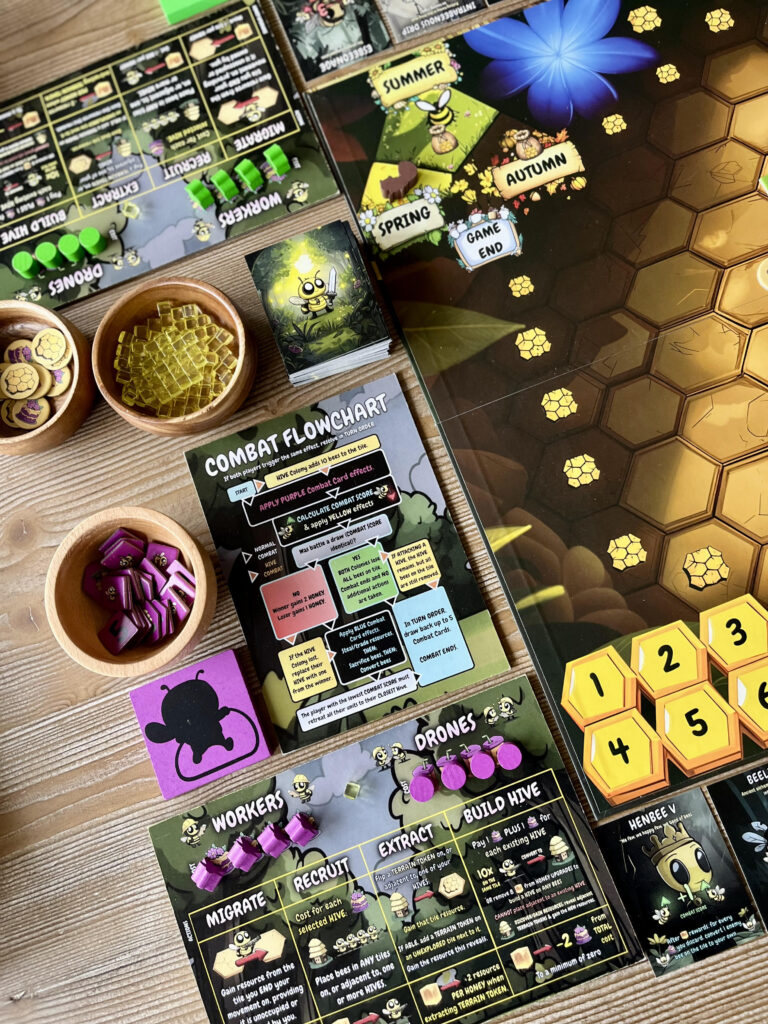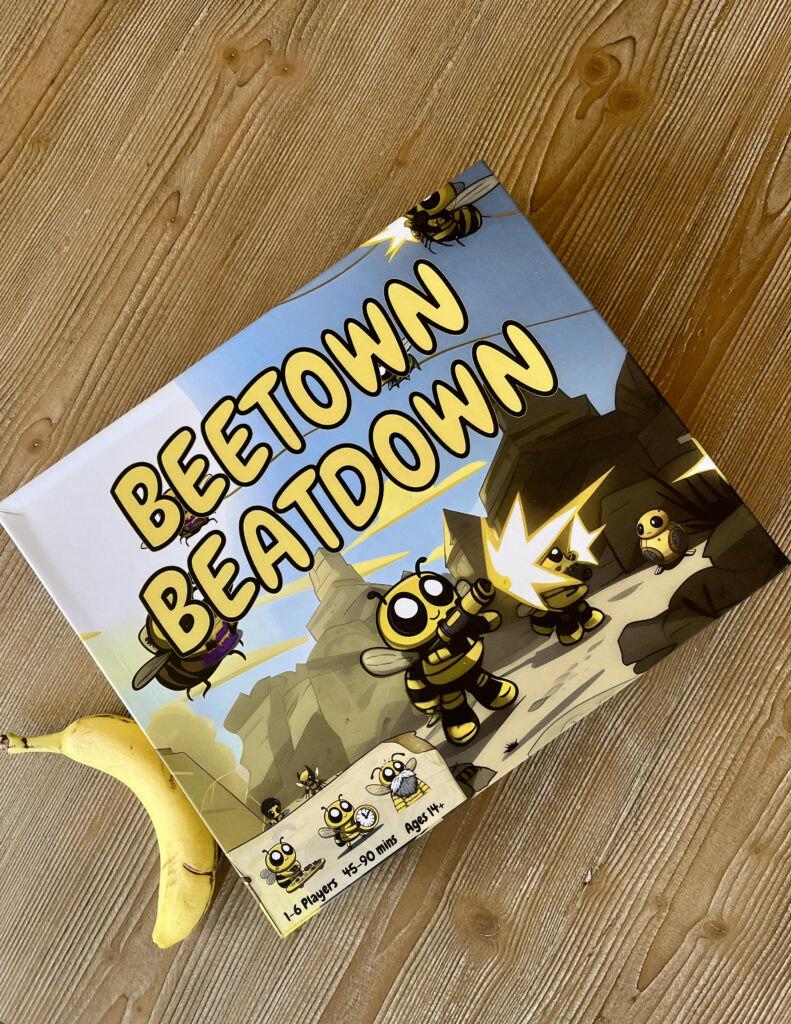Beetown Beetown has potential. Real, actual potential. And I think it’s close, but needs a few more tweaks.

To give a basic overview of the game, first I will mention that this is a prototype to be launching on Kickstarter some time in 2026. This is a 4X game in which each player is a Queen Bee, guiding their colony through exploration and area control. To win, you must control at least three hives on the board plus more than anyone else by the end of a season.
Each turn, players can take four basic actions, which can be upgraded using honey, a delightfully sticky resource that fuels most of the interesting decisions in the game. Of those four actions, Migrate is the golden child. Without upgrading it, your bees must be stuck in the honey because you only get to move one space. You can increase it, adding up to four honey, but until then you’ll have to enjoy your sticky stasis.
Initially, we all got excited about the Recruit upgrade, because obviously more bees = more fun. But then you run face-first into the game’s economy. Each worker placement costs increasingly more pollen (for Workers) or nectar (for Drones), and Recruit adds an extra pollen cost per hive. So unless you’re drowning in resources (you probably won’t be) this action becomes more and more of a punishment.
Pollen is pretty much the central, all-powerful resource that never seems to be around when you need it. Drawing tokens to reveal resources on newly explored hexes can be fun…and also frustrating when the wrong token turns up, effectively ending your turn early (possibly VERY early), while your opponent might be flocking in a field of abundance. It’s the type of randomness that feels a little like gambling, with the high highs and the low lows.
Upgrading Migrate helps a lot in easing this sting of randomness and also opening up more of the board. But this has to become an early goal or you’re going to be hurting a lot of the time.
Now I want to talk about the game’s size. It is…large. In its current state, Beetown Beatdown takes up enough table space to require city permits. But beyond the sprawl of the game, the components themselves are excessively large, like the turn skip token. Granted, this is all prototype material and while it’s all great quality, the size of the box alone would be a stopper for me. Personally, I lean hard towards compact designs, partly because we’re living in the golden age of board games, and partly because I like to still see my table underneath the components.

There are also some layout issues with the board, though this is minor. The shaded edges make it unclear where the map ends. We assumed full hexes were valid spaces, but “we assumed” is not something you want to say about your rule interpretation. Visually, the board looks like the inside of a hive, which makes sense until you realize you’re also building hives on it. Thematic clarity could use a little polish.
On the brighter side, the card art is excellent. Combat, while relatively simple, is fun because of the cards. They’re stylish and moody, almost reminding me a bit of the video game Hollow Knight, but with a bee pun flare . The rulebook’s explanation of combat, though, makes it seem much more complicated than it is. The instructions on the combat text color-coding make a simple process sound like quantum mechanics. Streamlining here would go a long way.
Back to honey- it’s a great mechanic. Upgrading actions is satisfying and opens up strategic depth, though the pace at which this happens feels a bit slow. At higher player counts, the game pushes you into combat more often, which speeds up honey collection and helps everything flow better. Because of this, the game almost definitely needs to be for 3+, but even 3 isn’t quite as fun. The Migrate action and combat are the 2 absolutely key elements to keep your bee economy running and if you don’t use combat, you won’t get honey to upgrade that Migrate action. For that reason, higher player counts are pretty necessary, otherwise you’re too spread out.
Now, I assume the designers of BB know this about the player count because they’ve designed a very interesting AI bot named STING. This has to be one of the most unique solo bots I’ve encountered in a game, and I think it’s very clever. It mixes and matches different card “themes” in a way that gives the bot different personalities. It might focus on building up hives, or you can make it super combat aggressive. The rulebook has tons of personality options for the bot and you can add multiple bot players into a game, each with a different personality. So in this way, more space is being used up by other Colonies and more clashing occurs.
The issue I generally run into again and again with solo bots in games, however, is I don’t want to run them. I want to play the game as intended and do my stuff. There are many times I’d rather just play two-handed solo instead of bothering to learn how to run the bot. But I’ll say this…while STING’s overhead exists, I’m much more interested in running something with an adaptable personality. There’s an excitement to this bot that I have never felt with any other solo mode, and it gives me hope that it’s possible to enjoy a solo mode.
As it stands, the solo cards could maybe play into the personalities a bit more. The cards are a tad procedural still and might benefit from something distracting from that. Perhaps artwork of angry bees for the warmongers etc.
Overall, Beetown Beatdown is a medium-heavy strategy game with some big ideas, some great moments, and a lot of ambeetion. It’s rough around the edges, but it’s trying. And that counts for a lot. If the designers can simplify a number of things, streamline the visual clarity, and please reconsider the box title font (which currently screams “middle school PowerPoint project”), this could be a really memorable title.